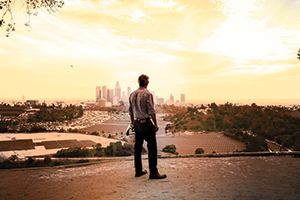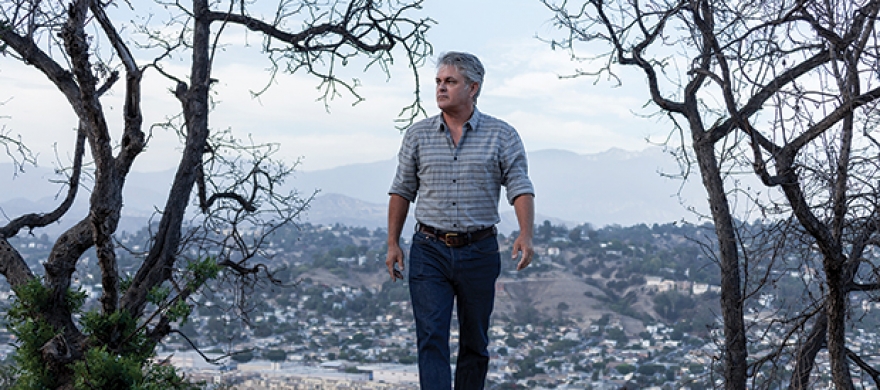Urban Legend
A childhood curiosity about the world around him propelled School of Public Policy professor Wade Graham into a lifelong exploration of the landscapes that define our lives.
We are strangely well trained in our culture to not see what’s around us,” suggests Wade Graham, adjunct faculty at the School of Public Policy, landscape architect, historian of modern urban life, and author. In his latest book Dream Cities: Seven Urban Ideas That Shape the World, Graham laments that even the most educated individuals are unaware of and possibly apathetic to the structures that form the backdrops to their lives.
Graham grew up 90 miles north of Los Angeles, up the coast of California in Santa
Barbara, an idyllic destination that has historically beckoned artists and visionaries
to the tony enclave tucked between lush green hillside and deep blue sea, a sort of
Mediterranean utopia lined with red-tiled roofs. His childhood home was what he calls
a “developer version” of a Case Study House, styled in a California mid-century modern
design with glass walls, post-and-beam construction, and a Danish sensibility throughout.
His mother, a professor, design enthusiast, and restaurateur, spent much of her time
perfecting the abode and developing its garden in the style of Lawrence Halprin, a
pioneer of modern landscape architecture. In a house soaking in postwar modernism,
Graham was exposed to the ideologies of David Gebhard, an architectural historian
and Santa Barbara architecture preservationist, by way of his father, himself a revered
historian and decorated academic.
Graham’s foray into the study of urban landscapes was “osmotic,” as he explains, a
product of growing up in a “very carefully constructed environment,” in which he became
acutely aware of the surroundings that shaped his—and others’—everyday life.
During a leave of absence from PhD studies in comparative literature at UCLA, Graham
was introduced to notable landscape designer Nancy Goslee Power, who hired him as
an apprentice after learning of his knowledge of the cultural history of California,
architecture, and graduate work in environmental history. On the job, he discovered
the euphoria of gardening he calls "garden magic,” a feeling of wonder that hearkens
to his childhood days of yard hopping through the bucolic properties that lined his
Southern California neighborhood in the 1970s.
In his first book, American Eden (2011), Graham gives a comprehensive history of how modern landscapes came to be
and how gardens influenced the environments in which we now live.
“There is no line drawn between environmental history and urban history,” Graham explains.
“If you do an environmental focus, you’re engaging with urban issues, and in the U.S.
in particular, you’re engaging with urban planning.”
The idea for his latest tome, Dream Cities, came to him in 2009 after teaching his first course on the history of American cities
at the School of Public Policy, which dives into U.S. urban and environmental policy
and attempts to open the eyes of his students to the world around them.
“We are knowledgeable about things that are portable, like cars or handbags, but not
so much about nature or buildings,” he explains. “People are very unengaged with their
physical environment. They structure our lives, but we’re blinded to it by training.”
In his class Graham builds a narrative around the forgotten landscapes that we so
often utilize but never engage with, monuments and structures that were built to disappear
into the background of everyday life. Students are led on field trips to sewage plants
and the bed of the Los Angeles River, and are encouraged to contemplate freeway diagrams,
all while using Dream Cities as an historical as well as a field guide. “It’s a revelation to us, because we’re
not trained to do it,” he explains.
“A light bulb goes on when you realize you’ve looked at something your whole life
and haven’t really seen it, and then you go ‘aha’ and understand the relationship
behind it: who it serves, what it serves, what ideas it promotes, and what ideas it
crushes,” Graham continues. “History, dynamism of environments ... my hope is for
people to stand in the middle of the street and be able to tell interesting stories
about what they see. I’m trying to get people to see their mundane world in a new
way.”
Dream Cities is Graham’s personal quest for an explanation for the kind of patterning seen in
all modern cities and to shed light on the history of modern architecture, its intentions,
its defining characteristics, and its power in shaping our lives. He discovered that,
when you stop to look around or while traveling, many cities built in the modern era—
which began in 1850—are constructed using the same pieces. The tower blocks, freeways,
shopping malls, parks, and gated communities you may see in Los Angeles can also be
seen in Minneapolis and Madrid.
“That needed explaining,” says Graham, who was also curious about the overlaps between
different structural groups. “You can find a gated community that is also a mall,
you can find a city hall that’s also a tower block. I wanted to understand where they
came from. They’re kind of like species. They’re incredibly successful. They are the
invasive species of the modern urban world.”
The book begins with an exploration of the pioneers who developed the modern world,
how they promoted their ideas, and what assumptions their ideologies carry in society.
“All of these things are an expression of some kind of idea about what will make life
better,” Graham explains. “All of them are Utopian, or even prescriptive. Take the
shopping mall: we think of it as a debased form, but the role of shopping architecture
is as exalted as religious architecture. It’s the oldest one we have.”
In Dream Cities, Graham reveals that the origins of modernism led to the destruction of the traditional
understanding of community and favored the restructuring of human life into segregated
spatial zones. He explains that this allowed the modernists to organize society in
mono-cultures. In other words, Graham posits that most of modern society’s social
and ethical issues—religious divisiveness, childhood obesity, crime rates, incarcerations—are
a direct result of the decisions of the original modernists. “Modernity segregated use by space, and that’s a vast shift of what the modern city
is. If you start segregating use by place, you start segregating people,” he explains.
“The primary downside of that is that it kills off interaction, it kills off pedestrian
life, it kills off diversity, and it kills off the complexity of the human experience.
The class and racial segregation was intentional, and it’s hard to reverse those decisions.”
“Modernity segregated use by space, and that’s a vast shift of what the modern city
is. If you start segregating use by place, you start segregating people,” he explains.
“The primary downside of that is that it kills off interaction, it kills off pedestrian
life, it kills off diversity, and it kills off the complexity of the human experience.
The class and racial segregation was intentional, and it’s hard to reverse those decisions.”
“The modernist project is toxic to community, and that was the point,” Graham continues.
“If you want to reverse that, you’re going to have to reverse course on dividing space
by use and by types of people and mix them back together. Modernism and community
have had a complex relationship, and we’re paying for it now.”
Graham also suggests that one hazardous side effect of urbanization is population
growth and the inability of cities to expand in response. His solution is an urban
model that can “scale up,” but doesn’t repeat the mistakes of the modernist city.
“In 1960, 250,000 people lived in Nairobi, Kenya, and it is now inhabited by nearly
3.5 million people, but they haven’t built anywhere near enough new roads or sewer
lines or proper housing to handle the growth. The overwhelming fact is population
growth, and that population growth is coming with urbanization,” Graham maintains.
“You have a situation in almost every country where cities are not keeping pace, or
cities are built on a model that doesn’t work when scaled up.”
Graham explains that the challenge is returning a level of pre-modern function to
modern cities—embracing new urbanism and community-based smart planning that has been
emerging all over the world, what he calls a “self-organizing urban organism.”
“There’s this incredible urgency and creativity about how to rethink cities and how
to reintegrate use and place,” he says. “That is the great riddle, the great success
story. We are beginning to reinhabit our central cities and unsegregating our suburbs.
It’s a positive, inspirational story, but also an aspirational one. As yet, it is
a very small percentage of our footprint, but mostly we all live in the modernist
dystopia of suburbs and shopping malls and parking lots. It’s a common experience,
but it is part of a big long arc that we’ve gone through culturally.”
Currently Graham is working on a book on the history of Los Angeles through the neighborhood
of Echo Park, which will rely on interviews and a house-by-house timeline of how the
city evolved into what it has become versus what it was conceived to be in the 1880s.
The book will focus on a local perspective, which will offer an understanding of the
larger journey of American cities through racial, economic, political, and cultural
changes that have taken place since the late 19th century.
Ultimately, Graham is fundamentally interested in Los Angeles and California. “It
is so interesting, so complex, and continuously evolving and eluding simple solutions,”
he says. “California is a complicated, interesting place. It’s quite a laboratory
to be in to look at policy of all kinds.”
All photos of Wade Graham courtesy of Calvin Lim
